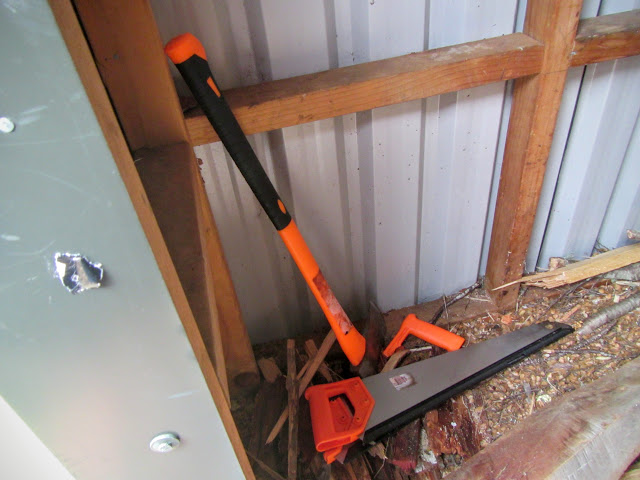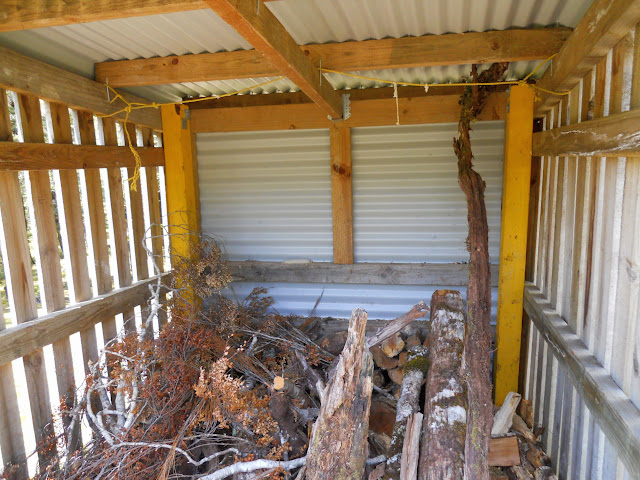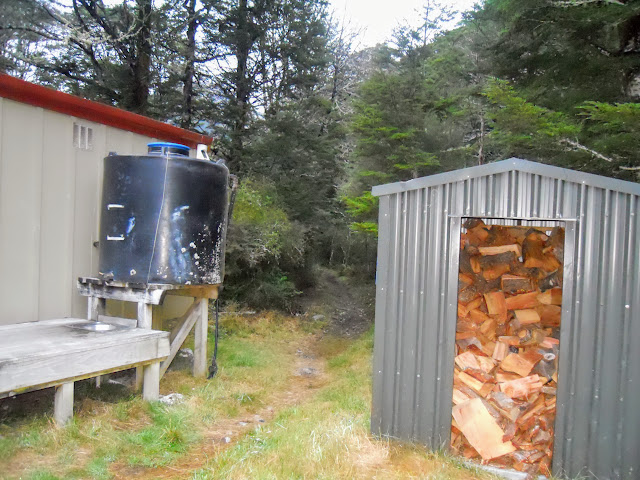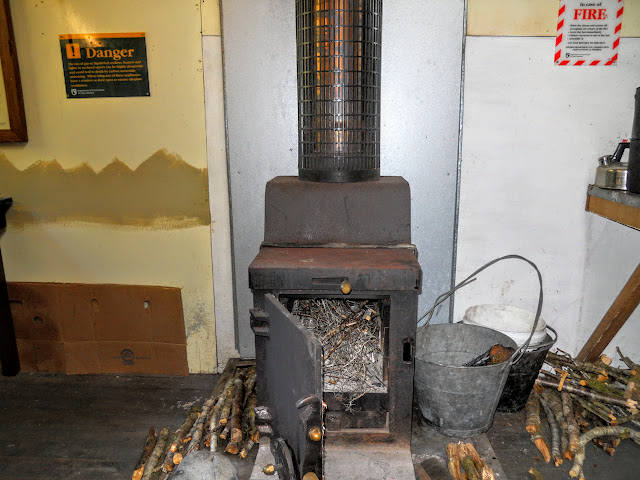Holy blazes.... fire starting, a vital outdoor skill!
The ability to build and light a fire when required is still a vital piece of tramping knowledge. Although the use of the fire as a cooking method has waned, fires built for heating, drying and survival purposes still have a place in the outdoors.
 |
| Blazing fire in Lakehead Hut on a cold rainy day |
I have seen some truly ghastly attempts to build fires while walking the Great Walk Tracks. Few people need to light a fire everyday to warm their home so those skills we all learnt as children have gone the way of the Walkman, fax, video cassette and dial landline phone.
 |
| Bliss...a mostly full woodshed at Manson-Nichols Hut, Lake Daniell |
I have no pretensions as an expert on the subject of wood craft or firestarting...what follows are just a few tips I have picked up along the way. Make of them what you will....
Do I REALLY need a fire?
The very first question you need to ask yourself is 'Do I really need to light a fire'?
Most people will say yes, but actually for much of the year a fire is total overkill. Rather than lighting a fire why don't you put some more clothes on! Even a hat, long pants and gloves make a difference. Another answer is to get into your sleeping bag to stay warm when it is windy or cool.
 |
| Jon says...try an insulating layer before lighting a fire! |
If you are sitting in a hut and it is 30 degrees outside it would be madness to start a fire. You may laugh but this has happened to me a couple of times. One blistering hot summer afternoon I arrived at John Tait Hut where two nearly naked German hikers had the fire going. The hut was hot...like 60 degrees hot! They had all the windows open because it was too damn hot in the hut to sit inside.
 |
| Blazing hot 30 degree day on the St James- not a good day for a fire! |
I suggested politely but firmly that possibly that wasn't an awesome idea...it took 6 hours for the hut to cool down!
 |
| John Tait Hut, Nelson Lakes NP |
Again if you are camping and it is raining it would also be mad to start a fire until you absolutely need to. You are going to find it hard to find dry wood, the rain will dampen your fire and you would be sitting outside getting warm on your front and wet everywhere else.
 |
| Cooking over fire in the rain...not my idea of fun. |
You need to carefully pick if and when you are going to light a fire.
When is a fire appropriate?
When is a fire appropriate I hear you say...good question! As already stated sometimes it is not appropriate to light a fire..in the rain, if it is a warm day, if there is little wood etc.. Here are some things to consider when deciding if the time is suitable to light a fire:
 |
| A more appropriate way to heat water at lunch- a gas canister stove! |
- How long is your stop? In the old days trampers made a fire every time they stopped for a billy brew, you can still do this but is it necessary.
- Wood supply: is there any wood available? Often the answer will be no, especially around the well used non serviced huts and above the bush-line. Try to conserve wood for when it is really required...
- If your supply of wood is limited perhaps you should wait until the evening to light your fire. That way you will have enough wood to see you through the coldest part of the day.
- Temperature: Do you REALLY need a fire if it is 30 degrees Celsius?
- Is there a fire ban in place? This is a lot more common now with climate change. check the fire status of your tramping location before setting out.
- Is a small fire more appropriate than a large one? You may only need a small fire to heat the newer 'insulated to death' DOC huts. Don't go overboard and try to melt the window glass...
You should ask yourself these questions every time you are contemplating a fire...
Wood selection for fire making:
So, you have decided a fire is needed and now you are going to build one. You will need wood, so what kind works best and how much do you need.
 |
| Driftwood makes excellent fuel for a fire...if dry! |
The quick answer is any wood that is dry- unfortunately this is often hard to locate. Look for standing dry wood, or wood which has been kept dry in a wood shed (at most DOC huts), under a large bush/tree or under a rock over hang. Driftwood along shorelines and riverbanks is also good provided it is dry.
Do not bother with rotten wood, it will never burn even if it is bone dry. Bark/cones are also difficult to light- keep them for when the fire is really blazing. Green wood recently cut will not burn and any wood that is saturated with water will not burn.
Don't even bother to gather these types of fuel....
 |
| Wet, rotten wood will not burn... |
Wood types that burn well are soft and easy to cut such as pine, kahikatea, beech, manuka/kanuka, poplar etc. Native hardwood's such as Rata, Rimu, Totara and Matai are hard to light but will burn for a long time, keep them for when the fire is roaring.
You need three types of fuel for a fire:
Tinder: Tinder provides the fire-starter for your blaze- it might be paper, dry grass, dry pine needles, frayed twine, steel wool, birds nests or dry papery tree bark. I like native Fuschia bark, it is a light paper like bark that will take a flame well.
 |
| A tinder bundle made of dried grass |
Kindling: Think finger sized or smaller; sticks, branches or slices cut from a larger log. I usually use a mixture of sticks and slices. If the sticks have thick bark try to slice them in half so they catch fire better as bark is notoriously difficult to light. A tightly bundled nest of beech leaves and branches is great to get a fire started....
 |
| Cutting logs into kindling, Lakehead Hut |
Logs/splits: These will range in size from arm thick to thigh thick depending on the type of fire. All logs work better if they are split i.e. cut into several slices. Wood with edges burns better than full round logs due to the bark. If the fire is in a hut make sure the splits are short enough to fit into the wood burner or fireplace.
 |
| Some log splits for the wood box in John Tait Hut, Nelson Lakes NP |
Once you have your wood sorted you need some tools to break it into manageable pieces.
Tools of the trade:
Your first tool is yourself, break small branches in your hand, over the knee or around a tree. Slightly larger versions can be leaned against a rock/tree/step and broken in half with your feet. Breaking wood this way is as old as humanity, we have used this method for the last 100 000 years.
 |
| Firewood: this level of commitment is not required... |
Other tools you will use are axes, saws and knives. If you are in a DOC hut there will probably be either an axe or a saw for firewood preparation. It is easier to saw any logs into manageable rounds and then split them with the axe- chopping through a log is an exercise in frustration!
 |
| Tools of the trade: Axe and saw... |
If you are camping you will need to make due with what you can find, break by hand or use whatever knife you carry. If you are a machete, parang or kukri carrier you are set...they are all basically small axes. If like me you only carry a Swiss army knife then hand broken wood is your only option.
 |
| The Kukri I carried in the Army- awesome knife/axe but bloody heavy! |
If you have a suitable knife, grab a piece of hard wood and use it as a hammer to drive your knife through thinner pieces of wood. Try not to chop wood with a knife as you will quickly blunt the blade....
 |
| Using a knife and a log hammer to split wood, photo Paul Kirtley |
Regardless of the tool always be safety conscious- take care using any sharp blade, don't let minors cut wood, wear boots when chopping and try to get home without losing a finger, hand or limb....
Types of fires:
There are many different formations you can use when you first start a fire, the most common are the teepee, log cabin and upside down pyramid. All of these use the same basic premise; a structure is built around and above the tinder. Once the blaze is going well the larger splits will collapse forming a good bed of coals for large pieces of wood.
 |
| Some different types of fire formation |
Another type is the star fire. The star fire formation is a good choice for a slow burning fire in areas with little wood or where only larger logs are available. You can gradually feed the logs into the center of the fire as the wood burns down.
 |
| Classic star pattern fire set up.... |
It is surprising how much heat this type of fire produces...BTW they are also good for cooking fires.
Building an outdoor fire...
The skills used building a fire indoors or outdoors are very similar, you use the same process in both cases. Obviously when you are outside you will only have the tools you are carrying to assist you. If you are camping at a DOC campsite next to a hut you can use the axe/saw located there.
 |
| A scratch camping spot with fire circle near Mt Richardson, Canterbury |
When building an outdoor fire you need to follow these steps;
- Locate a site for your fire. When using 'leave no trace' methods this should be in an existing fire circle, or on a hard impermeable surface such as rock, compacted sand or compacted soil
- Gather your wood: you need tinder, kindling and fuel wood. Make sure you have more than enough wood to maintain the fire until it is going well
- Place a bunch of tinder in the middle of your camp-fire site, if the ground is damp construct a wood platform for the tinder to rest on using larger kindling
- Form an initial teepee of small kindling around your tinder regardless of the form of fire you are building
- Add kindling to the pile, working up to pencil sized pieces
- Create a larger teepee/log cabin/upside down pyramid around and above your kindling teepee using fuel wood,
- Light your fire. If you have some type of fire starter (commercial/rubber tube/candle stub/soaked cotton waste) this is when you should use it.
 |
| Different types of firewood ready for use |
 |
| Lighting a classic 'pyramid' fire outdoors...note the hard rocky ground |
 |
| A small campfire at the Ryde Falls camp-site, November 2012 |
Please make sure that you:
- Conserve wood- only use what you need, when you need it- don't waste wood just because it is there. Leave some for the people coming after you.
- Keep fires small, they use less fuel and usually do the job perfectly adequately.
- Don't use smooth river stones in a fire circle- they may explode as they heat up and expand. They absorb water while in the river and release it in a flash of steam.....
- Don't light a fire on humus (the dry, crumbly soil you find on a forest floor) as it can smolder and eventually catch fire long after you are gone.
- Watch your fire, never leave it unattended in case it gets out of control and starts a larger fire.
- Make sure it is fully out before departing: use the douse, crush and mix method. Put the fire out with water/soil/sand then crush the embers with your feet. Mix it around with a stick to make sure all embers are out. Repeat until fully doused.
 |
| How to ensure a fire is fully out... |
Building a fire in a hut
Almost all DOC huts will have a heat source of some sort, generally these will be open fires, pot belly stoves or wood burners. A few of the Great Walk huts have gas heaters, usually only during the Summer season.
 |
| A nice warming fire at Manson-Nichols Hut, Lake Daniell |
In general terms you need the same resources for a hut fire as a camp fire: tinder, kindling and wood. If you are lucky (for instance if I was at the hut before you) you will arrive to find a supply of all three ready and waiting. If you are unlucky you will need to gather/process your own.
 |
| Fire prep done and wood laid in for when needed at Nina Hut |
Your first port of call should be the hut woodshed...most Serviced and Standard huts will have one. Wither there is any wood in them is a different matter. Great Walk huts will of course have fuel..that is partially what you are paying the big bucks for. Most will have a ready supply of wood, coal (being phased out...) or gas for a gas heater. If there is none visible ask the DOC hut warden as they sometimes ration the wood.
 |
| Partially full wood shed at Nina Hut, Lewis Pass Scenic Reserve |
 |
| Look at that beauty: a full wood shed at John Tait Hut |
If there is no wood shed or it is empty start foraging in the bush for your wood. I gathered all the wood in the photo below in less than 30 minutes from the forest around Lakehead Hut in Nelson Lakes NP. The wood is small as the area had been picked over BUT it is still wood and provided fuel for warmth for two nights.....
 |
| Lakehead Hut...firewood I gathered from the local bush... |
Construct your wood burner fire as you would for a camp fire. Use either a tee pee, pyramid or log cabin. The tinder goes in the center with small kindling stacked around and over it. Have a supply of larger pieces of wood on hand for when the fire takes. Once you have a base of coals in the fire box you can start to add these larger splits as they need intense heat to ignite.
 |
| Basic framework for your fire- log cabin type |
 |
| Ready to go: tinder and kindling added...note the air regulator |
There is an airflow control on most DOC wood burners...pushing it to the right increases the air flow while pushing it to the left decreases it. I normally start at the middle position and adjust it once the wood is well aflame. I also find leaving the door open about 1 cm helps the flames to take when initially starting the fire.
Shut the door once the fire is burning well...don't burn down the hut.
 |
| It need not be perfect...my slightly shambolic pyramid...it still worked! |
 |
| Supply of wood ready for when the fire requires it... |
Some huts will also supply coal for the hut fireplace. I'm constantly surprised by the number of people who have never used coal before, when I was young everyone burnt it on their open fires so everyone knew how to use it.
 |
| A bag of coal in fire woodshed, old Manson-Nichols Hut (2016) |
To use coal, first build a fire as described with wood. Once you have a nice bed of hot embers evenly spread a small shovel full of coal over the top. Take it easy with that shovel though, too much and you will smother your fire. Watch the coal dust as it can be explosive in the right conditions...if your coal is dusty gently sift it over the fire. Don't chuck it in all at once...or BOOOOMMMM!!!
 |
| Coal being used in an open fireplace...intense heat!!! |
I know there are environmental issues with using coal, but it is much more efficient that burning wood. Coal will give you a long, slow and even burn and it puts out a lot more heat than wood so if it is available use it. DOC have started to phase it out as a heating fuel...it will be gone from all huts by 2023.
What to do once the fight is burning
So, what do you do once the fire is actually burning...you add more wood to it but do so SLOWLY!
"....Yess, Garry, Yess..."
 |
| Larger splits being added to a well blazing fire... |
Jamming 14 logs into a fire box just because you can see some flames is a recipe for killing any fire. Add progressively bigger splits of wood until you have a hot bed of embers, this is when you can add those larger chunks of wood to the flames. This applies to hut fires and open fires.
If the fire goes out...start again from scratch. Even I have had to restart fires a couple of times. Unfortunately, the fire god 'Burnslikehellum' likes to play jolly japes on you...don't fret just quietly reset. Go back to the beginning....get it going and then burn his ass......
Practice makes perfect
It is really important to practice your fire construction skills, even if you don't actually light the fire. Take the opportunity when you go for a tramp to locate and prepare fire making materials. Chop wood at huts and split some for kindling- you are practicing your skills and making someone else's visit easier.
 |
| In the firebox and ready to go, Mid Robinson Hut |
Keep an eye out for good tinder, I collect Fuschia bark every time I see one of these trees as they make excellent tinder. I have a couple of kilos of it at home drying out for future use. I always carry a handful of it in a tied off plastic bag as an emergency back up.
 |
| Paper like bark of the native Fuschia Tree...great tinder! |
Don't be afraid to chuck a couple of commercial firestarter cubes into a plastic bag and carry them with you. Wet wood is a bastard to start but the long burning flame from a Sambra Cube normally works. Another alternative is a couple of Esbit/hexamine fuel tablets which will work as a firestarter and can be used in an emergency to heat water/food.
Final thoughts on fire making...
When I am tramping in the summer months
(when fires are less of a necessity) I always take the opportunity to cut & gather wood when I get to a hut. Cut some kindling and gather dry branches, put these in the woodshed, under the veranda or under the hut if possible so they can dry.
 |
| Best way to stack ready use wood- cross hatch stack- it dries faster |
I wont need it but I'm providing for leaner times when dry wood is not so easy to locate. If you pass a likely looking log close to a hut by all means carry it with you, chop it up and put it in the wood shed. Obviously don't carry it for 5 kilometers just in case...that would be mad.
Only collect it within 100 meters of the hut!!!
 |
| Oooww...firewood and only twenty meters from the hut... |
One other point- all of these skills are covered in a basic bush-craft course run by climbing/tramping clubs and safety organisations. If you want to get some fire making skills sign up for one of these courses and learn how to do it from an expert.
 |
| Swinging the billy on a outdoor fire...a Kiwi tramping tradition! |
Be safety conscious- don't leave a fire un-attended and for pity's sake don't touch a wood burner once it is going. Those bastids get hot!
Cheers!































